Exploring the Core Functions and Achievements of the WTO: A Report
VerifiedAdded on 2022/12/20
|6
|1539
|90
Report
AI Summary
This report examines the primary functions of the World Trade Organization (WTO), focusing on its role in facilitating and supervising trade practices. The WTO's core functions include administering trade agreements, providing a platform for negotiations, and resolving trade disputes. The report details how the WTO achieves these functions through the Marrakesh Agreement, negotiation forums like the Doha Round, and the Dispute Settlement Understanding (DSU). It also highlights the WTO's cooperation with international agencies to enhance global economic policy-making. The report emphasizes the importance of the WTO in promoting smooth trade flows and resolving international trade issues, ultimately aiming to improve international business practices and global trade relations. The report also covers the technical assistance programs conducted by the WTO Secretariat, which guide the participating countries to better identification of the needs and priorities during the course of the trade facilitation negotiations.

Paraphrase This Document
Need a fresh take? Get an instant paraphrase of this document with our AI Paraphraser
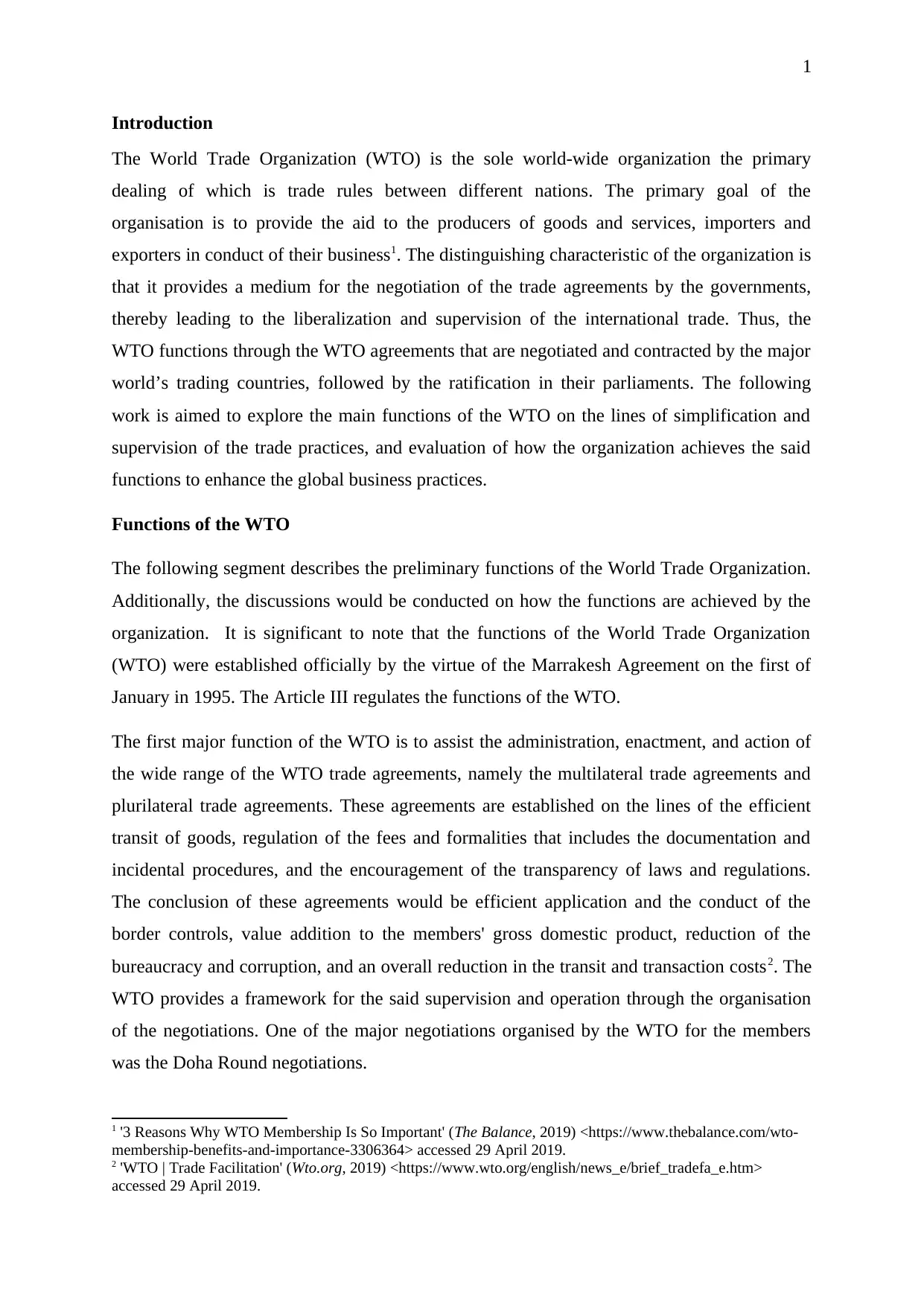
1
Introduction
The World Trade Organization (WTO) is the sole world-wide organization the primary
dealing of which is trade rules between different nations. The primary goal of the
organisation is to provide the aid to the producers of goods and services, importers and
exporters in conduct of their business1. The distinguishing characteristic of the organization is
that it provides a medium for the negotiation of the trade agreements by the governments,
thereby leading to the liberalization and supervision of the international trade. Thus, the
WTO functions through the WTO agreements that are negotiated and contracted by the major
world’s trading countries, followed by the ratification in their parliaments. The following
work is aimed to explore the main functions of the WTO on the lines of simplification and
supervision of the trade practices, and evaluation of how the organization achieves the said
functions to enhance the global business practices.
Functions of the WTO
The following segment describes the preliminary functions of the World Trade Organization.
Additionally, the discussions would be conducted on how the functions are achieved by the
organization. It is significant to note that the functions of the World Trade Organization
(WTO) were established officially by the virtue of the Marrakesh Agreement on the first of
January in 1995. The Article III regulates the functions of the WTO.
The first major function of the WTO is to assist the administration, enactment, and action of
the wide range of the WTO trade agreements, namely the multilateral trade agreements and
plurilateral trade agreements. These agreements are established on the lines of the efficient
transit of goods, regulation of the fees and formalities that includes the documentation and
incidental procedures, and the encouragement of the transparency of laws and regulations.
The conclusion of these agreements would be efficient application and the conduct of the
border controls, value addition to the members' gross domestic product, reduction of the
bureaucracy and corruption, and an overall reduction in the transit and transaction costs2. The
WTO provides a framework for the said supervision and operation through the organisation
of the negotiations. One of the major negotiations organised by the WTO for the members
was the Doha Round negotiations.
1 '3 Reasons Why WTO Membership Is So Important' (The Balance, 2019) <https://www.thebalance.com/wto-
membership-benefits-and-importance-3306364> accessed 29 April 2019.
2 'WTO | Trade Facilitation' (Wto.org, 2019) <https://www.wto.org/english/news_e/brief_tradefa_e.htm>
accessed 29 April 2019.
Introduction
The World Trade Organization (WTO) is the sole world-wide organization the primary
dealing of which is trade rules between different nations. The primary goal of the
organisation is to provide the aid to the producers of goods and services, importers and
exporters in conduct of their business1. The distinguishing characteristic of the organization is
that it provides a medium for the negotiation of the trade agreements by the governments,
thereby leading to the liberalization and supervision of the international trade. Thus, the
WTO functions through the WTO agreements that are negotiated and contracted by the major
world’s trading countries, followed by the ratification in their parliaments. The following
work is aimed to explore the main functions of the WTO on the lines of simplification and
supervision of the trade practices, and evaluation of how the organization achieves the said
functions to enhance the global business practices.
Functions of the WTO
The following segment describes the preliminary functions of the World Trade Organization.
Additionally, the discussions would be conducted on how the functions are achieved by the
organization. It is significant to note that the functions of the World Trade Organization
(WTO) were established officially by the virtue of the Marrakesh Agreement on the first of
January in 1995. The Article III regulates the functions of the WTO.
The first major function of the WTO is to assist the administration, enactment, and action of
the wide range of the WTO trade agreements, namely the multilateral trade agreements and
plurilateral trade agreements. These agreements are established on the lines of the efficient
transit of goods, regulation of the fees and formalities that includes the documentation and
incidental procedures, and the encouragement of the transparency of laws and regulations.
The conclusion of these agreements would be efficient application and the conduct of the
border controls, value addition to the members' gross domestic product, reduction of the
bureaucracy and corruption, and an overall reduction in the transit and transaction costs2. The
WTO provides a framework for the said supervision and operation through the organisation
of the negotiations. One of the major negotiations organised by the WTO for the members
was the Doha Round negotiations.
1 '3 Reasons Why WTO Membership Is So Important' (The Balance, 2019) <https://www.thebalance.com/wto-
membership-benefits-and-importance-3306364> accessed 29 April 2019.
2 'WTO | Trade Facilitation' (Wto.org, 2019) <https://www.wto.org/english/news_e/brief_tradefa_e.htm>
accessed 29 April 2019.
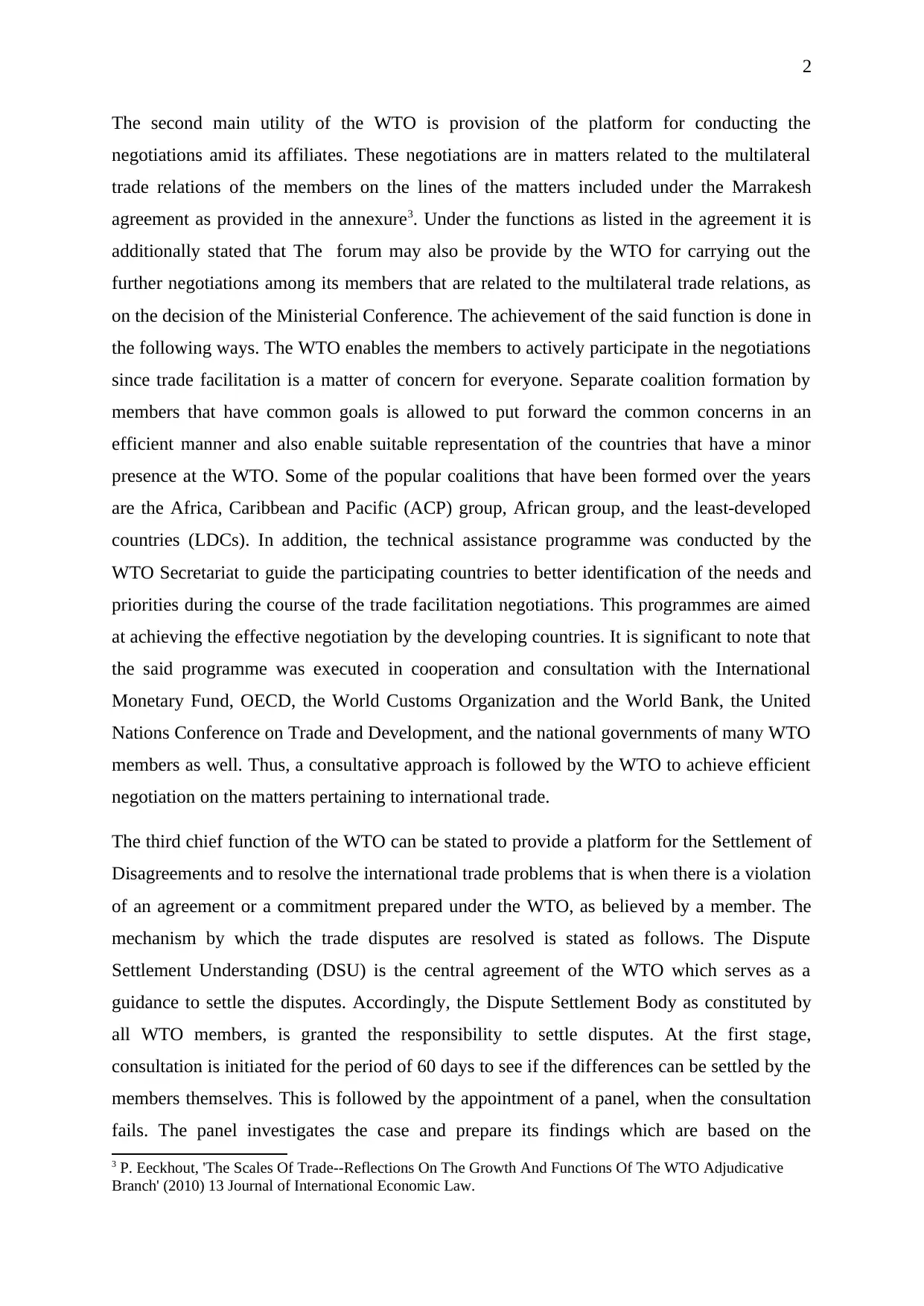
2
The second main utility of the WTO is provision of the platform for conducting the
negotiations amid its affiliates. These negotiations are in matters related to the multilateral
trade relations of the members on the lines of the matters included under the Marrakesh
agreement as provided in the annexure3. Under the functions as listed in the agreement it is
additionally stated that The forum may also be provide by the WTO for carrying out the
further negotiations among its members that are related to the multilateral trade relations, as
on the decision of the Ministerial Conference. The achievement of the said function is done in
the following ways. The WTO enables the members to actively participate in the negotiations
since trade facilitation is a matter of concern for everyone. Separate coalition formation by
members that have common goals is allowed to put forward the common concerns in an
efficient manner and also enable suitable representation of the countries that have a minor
presence at the WTO. Some of the popular coalitions that have been formed over the years
are the Africa, Caribbean and Pacific (ACP) group, African group, and the least-developed
countries (LDCs). In addition, the technical assistance programme was conducted by the
WTO Secretariat to guide the participating countries to better identification of the needs and
priorities during the course of the trade facilitation negotiations. This programmes are aimed
at achieving the effective negotiation by the developing countries. It is significant to note that
the said programme was executed in cooperation and consultation with the International
Monetary Fund, OECD, the World Customs Organization and the World Bank, the United
Nations Conference on Trade and Development, and the national governments of many WTO
members as well. Thus, a consultative approach is followed by the WTO to achieve efficient
negotiation on the matters pertaining to international trade.
The third chief function of the WTO can be stated to provide a platform for the Settlement of
Disagreements and to resolve the international trade problems that is when there is a violation
of an agreement or a commitment prepared under the WTO, as believed by a member. The
mechanism by which the trade disputes are resolved is stated as follows. The Dispute
Settlement Understanding (DSU) is the central agreement of the WTO which serves as a
guidance to settle the disputes. Accordingly, the Dispute Settlement Body as constituted by
all WTO members, is granted the responsibility to settle disputes. At the first stage,
consultation is initiated for the period of 60 days to see if the differences can be settled by the
members themselves. This is followed by the appointment of a panel, when the consultation
fails. The panel investigates the case and prepare its findings which are based on the
3 P. Eeckhout, 'The Scales Of Trade--Reflections On The Growth And Functions Of The WTO Adjudicative
Branch' (2010) 13 Journal of International Economic Law.
The second main utility of the WTO is provision of the platform for conducting the
negotiations amid its affiliates. These negotiations are in matters related to the multilateral
trade relations of the members on the lines of the matters included under the Marrakesh
agreement as provided in the annexure3. Under the functions as listed in the agreement it is
additionally stated that The forum may also be provide by the WTO for carrying out the
further negotiations among its members that are related to the multilateral trade relations, as
on the decision of the Ministerial Conference. The achievement of the said function is done in
the following ways. The WTO enables the members to actively participate in the negotiations
since trade facilitation is a matter of concern for everyone. Separate coalition formation by
members that have common goals is allowed to put forward the common concerns in an
efficient manner and also enable suitable representation of the countries that have a minor
presence at the WTO. Some of the popular coalitions that have been formed over the years
are the Africa, Caribbean and Pacific (ACP) group, African group, and the least-developed
countries (LDCs). In addition, the technical assistance programme was conducted by the
WTO Secretariat to guide the participating countries to better identification of the needs and
priorities during the course of the trade facilitation negotiations. This programmes are aimed
at achieving the effective negotiation by the developing countries. It is significant to note that
the said programme was executed in cooperation and consultation with the International
Monetary Fund, OECD, the World Customs Organization and the World Bank, the United
Nations Conference on Trade and Development, and the national governments of many WTO
members as well. Thus, a consultative approach is followed by the WTO to achieve efficient
negotiation on the matters pertaining to international trade.
The third chief function of the WTO can be stated to provide a platform for the Settlement of
Disagreements and to resolve the international trade problems that is when there is a violation
of an agreement or a commitment prepared under the WTO, as believed by a member. The
mechanism by which the trade disputes are resolved is stated as follows. The Dispute
Settlement Understanding (DSU) is the central agreement of the WTO which serves as a
guidance to settle the disputes. Accordingly, the Dispute Settlement Body as constituted by
all WTO members, is granted the responsibility to settle disputes. At the first stage,
consultation is initiated for the period of 60 days to see if the differences can be settled by the
members themselves. This is followed by the appointment of a panel, when the consultation
fails. The panel investigates the case and prepare its findings which are based on the
3 P. Eeckhout, 'The Scales Of Trade--Reflections On The Growth And Functions Of The WTO Adjudicative
Branch' (2010) 13 Journal of International Economic Law.
⊘ This is a preview!⊘
Do you want full access?
Subscribe today to unlock all pages.

Trusted by 1+ million students worldwide
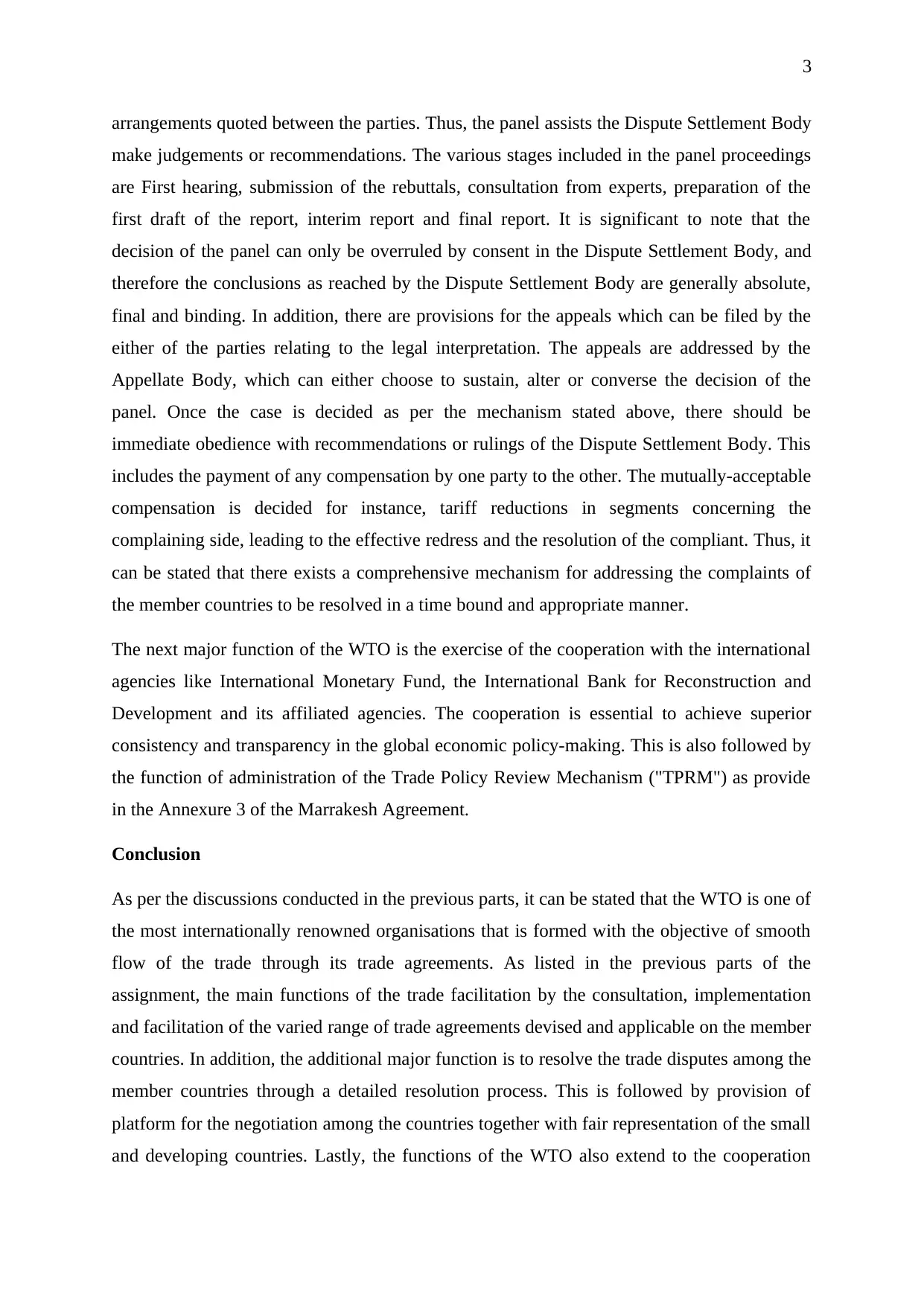
3
arrangements quoted between the parties. Thus, the panel assists the Dispute Settlement Body
make judgements or recommendations. The various stages included in the panel proceedings
are First hearing, submission of the rebuttals, consultation from experts, preparation of the
first draft of the report, interim report and final report. It is significant to note that the
decision of the panel can only be overruled by consent in the Dispute Settlement Body, and
therefore the conclusions as reached by the Dispute Settlement Body are generally absolute,
final and binding. In addition, there are provisions for the appeals which can be filed by the
either of the parties relating to the legal interpretation. The appeals are addressed by the
Appellate Body, which can either choose to sustain, alter or converse the decision of the
panel. Once the case is decided as per the mechanism stated above, there should be
immediate obedience with recommendations or rulings of the Dispute Settlement Body. This
includes the payment of any compensation by one party to the other. The mutually-acceptable
compensation is decided for instance, tariff reductions in segments concerning the
complaining side, leading to the effective redress and the resolution of the compliant. Thus, it
can be stated that there exists a comprehensive mechanism for addressing the complaints of
the member countries to be resolved in a time bound and appropriate manner.
The next major function of the WTO is the exercise of the cooperation with the international
agencies like International Monetary Fund, the International Bank for Reconstruction and
Development and its affiliated agencies. The cooperation is essential to achieve superior
consistency and transparency in the global economic policy-making. This is also followed by
the function of administration of the Trade Policy Review Mechanism ("TPRM") as provide
in the Annexure 3 of the Marrakesh Agreement.
Conclusion
As per the discussions conducted in the previous parts, it can be stated that the WTO is one of
the most internationally renowned organisations that is formed with the objective of smooth
flow of the trade through its trade agreements. As listed in the previous parts of the
assignment, the main functions of the trade facilitation by the consultation, implementation
and facilitation of the varied range of trade agreements devised and applicable on the member
countries. In addition, the additional major function is to resolve the trade disputes among the
member countries through a detailed resolution process. This is followed by provision of
platform for the negotiation among the countries together with fair representation of the small
and developing countries. Lastly, the functions of the WTO also extend to the cooperation
arrangements quoted between the parties. Thus, the panel assists the Dispute Settlement Body
make judgements or recommendations. The various stages included in the panel proceedings
are First hearing, submission of the rebuttals, consultation from experts, preparation of the
first draft of the report, interim report and final report. It is significant to note that the
decision of the panel can only be overruled by consent in the Dispute Settlement Body, and
therefore the conclusions as reached by the Dispute Settlement Body are generally absolute,
final and binding. In addition, there are provisions for the appeals which can be filed by the
either of the parties relating to the legal interpretation. The appeals are addressed by the
Appellate Body, which can either choose to sustain, alter or converse the decision of the
panel. Once the case is decided as per the mechanism stated above, there should be
immediate obedience with recommendations or rulings of the Dispute Settlement Body. This
includes the payment of any compensation by one party to the other. The mutually-acceptable
compensation is decided for instance, tariff reductions in segments concerning the
complaining side, leading to the effective redress and the resolution of the compliant. Thus, it
can be stated that there exists a comprehensive mechanism for addressing the complaints of
the member countries to be resolved in a time bound and appropriate manner.
The next major function of the WTO is the exercise of the cooperation with the international
agencies like International Monetary Fund, the International Bank for Reconstruction and
Development and its affiliated agencies. The cooperation is essential to achieve superior
consistency and transparency in the global economic policy-making. This is also followed by
the function of administration of the Trade Policy Review Mechanism ("TPRM") as provide
in the Annexure 3 of the Marrakesh Agreement.
Conclusion
As per the discussions conducted in the previous parts, it can be stated that the WTO is one of
the most internationally renowned organisations that is formed with the objective of smooth
flow of the trade through its trade agreements. As listed in the previous parts of the
assignment, the main functions of the trade facilitation by the consultation, implementation
and facilitation of the varied range of trade agreements devised and applicable on the member
countries. In addition, the additional major function is to resolve the trade disputes among the
member countries through a detailed resolution process. This is followed by provision of
platform for the negotiation among the countries together with fair representation of the small
and developing countries. Lastly, the functions of the WTO also extend to the cooperation
Paraphrase This Document
Need a fresh take? Get an instant paraphrase of this document with our AI Paraphraser
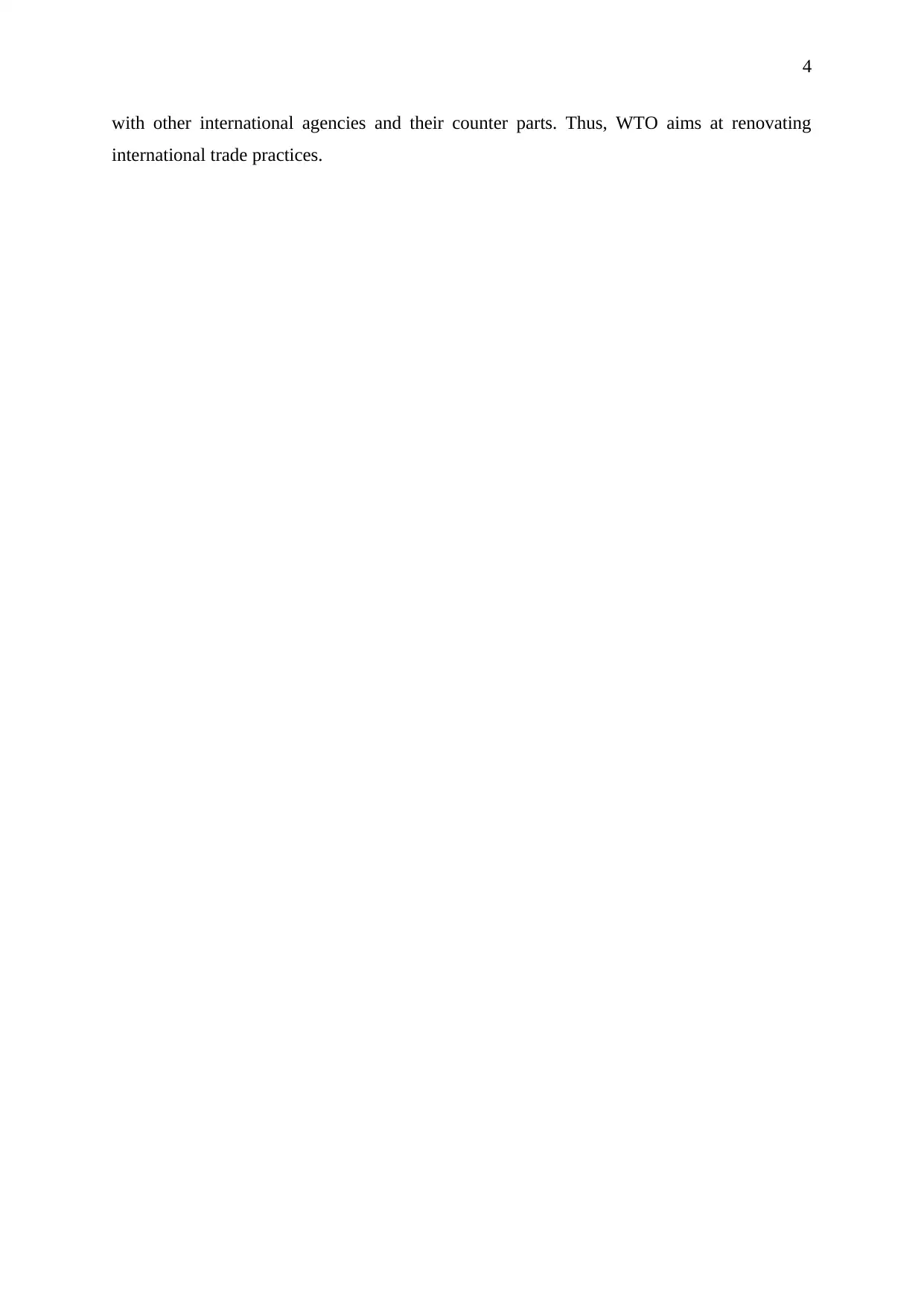
4
with other international agencies and their counter parts. Thus, WTO aims at renovating
international trade practices.
with other international agencies and their counter parts. Thus, WTO aims at renovating
international trade practices.
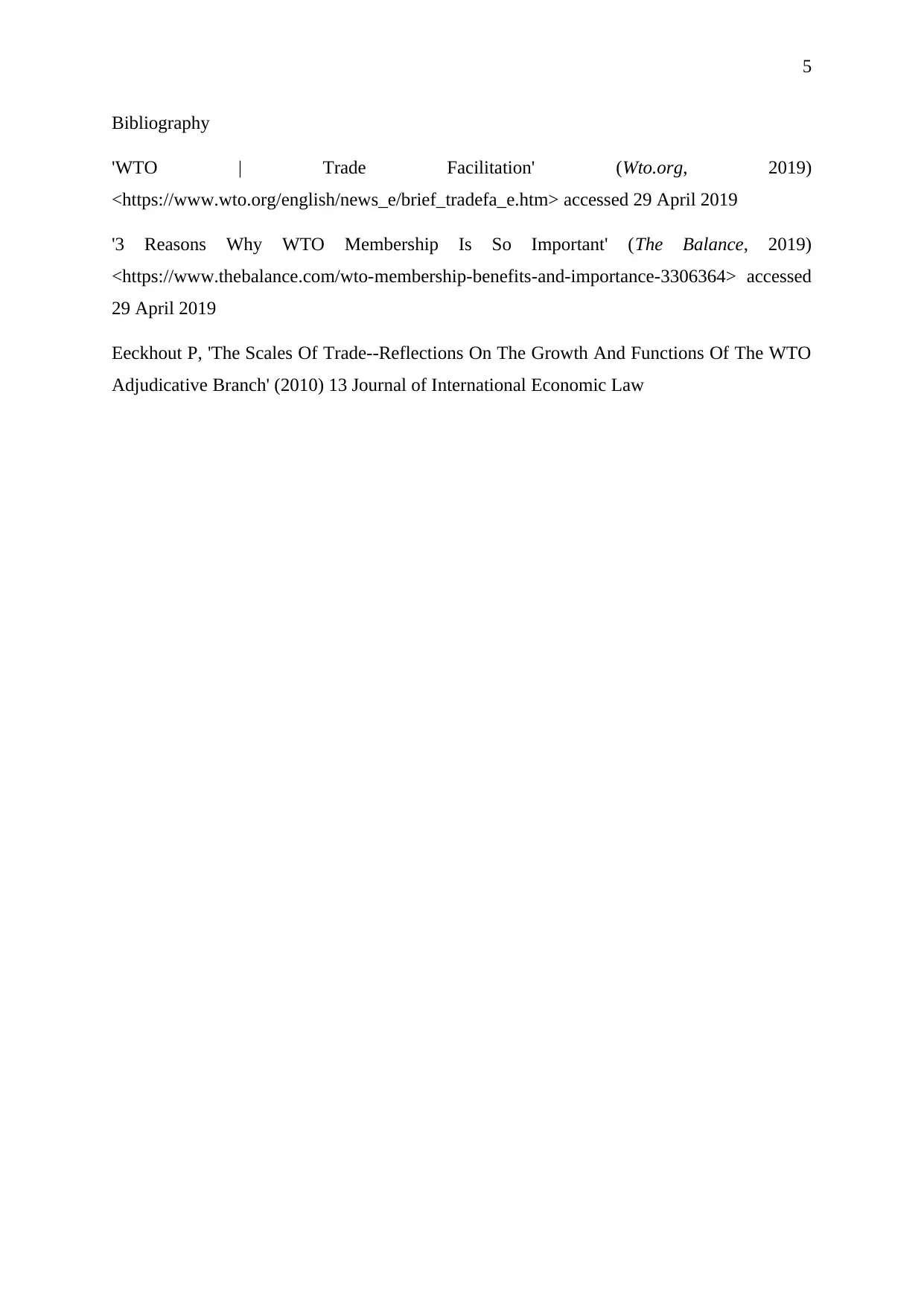
5
Bibliography
'WTO | Trade Facilitation' (Wto.org, 2019)
<https://www.wto.org/english/news_e/brief_tradefa_e.htm> accessed 29 April 2019
'3 Reasons Why WTO Membership Is So Important' (The Balance, 2019)
<https://www.thebalance.com/wto-membership-benefits-and-importance-3306364> accessed
29 April 2019
Eeckhout P, 'The Scales Of Trade--Reflections On The Growth And Functions Of The WTO
Adjudicative Branch' (2010) 13 Journal of International Economic Law
Bibliography
'WTO | Trade Facilitation' (Wto.org, 2019)
<https://www.wto.org/english/news_e/brief_tradefa_e.htm> accessed 29 April 2019
'3 Reasons Why WTO Membership Is So Important' (The Balance, 2019)
<https://www.thebalance.com/wto-membership-benefits-and-importance-3306364> accessed
29 April 2019
Eeckhout P, 'The Scales Of Trade--Reflections On The Growth And Functions Of The WTO
Adjudicative Branch' (2010) 13 Journal of International Economic Law
⊘ This is a preview!⊘
Do you want full access?
Subscribe today to unlock all pages.

Trusted by 1+ million students worldwide
1 out of 6
Related Documents
Your All-in-One AI-Powered Toolkit for Academic Success.
+13062052269
info@desklib.com
Available 24*7 on WhatsApp / Email
![[object Object]](/_next/static/media/star-bottom.7253800d.svg)
Unlock your academic potential
Copyright © 2020–2025 A2Z Services. All Rights Reserved. Developed and managed by ZUCOL.




